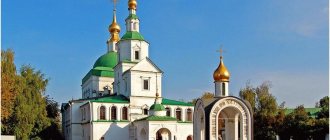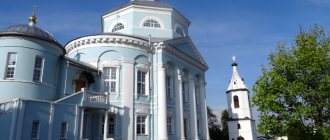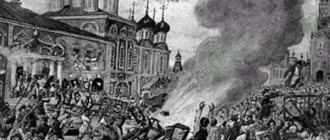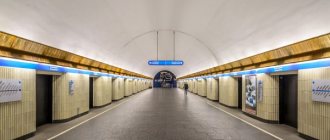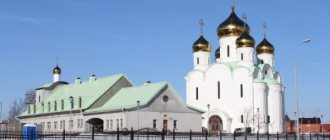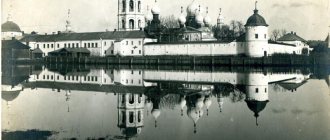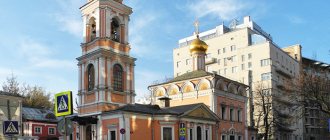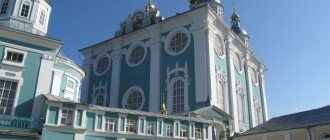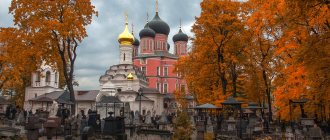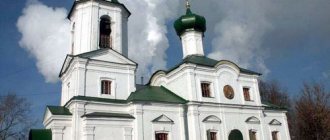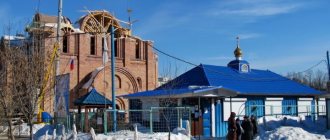Vysoko-Petrovsky Monastery attracts pilgrims from all over Russia and neighboring countries. This is not only the center of spiritual life, but also a real complex of cultural monuments: one cathedral, five temples, a chapel, a bell tower and monastery buildings.
It is located in the central part of Moscow, on the corner of Petrovka Street and Petrovsky Boulevard. This monastery is often called “invisible”: the fact is that it occupies an entire block, and few people know about its existence. This is due to the fact that the complex is sandwiched by Moscow high-rise buildings and narrow streets.
© Evgeny ev6795
Vysoko-Petrovsky Monastery today
The Vysoko-Petrovsky Moscow Monastery is a complex consisting of the following objects:
- Secret building.
- Fountain.
- South Gate.
- Abbot's corps.
- Gallery.
- Belfry.
- Former profitable monastery house.
In addition, on the territory of the Lavra there are the following temples and chapels:
- Chapel of the Naryshkin family.
- Cathedral of St. Petra.
- Church of St. apostles Paul and Peter.
- Cell church in a secret building.
- Above the South Gate is the temple of St. Great Pachomius.
- Sergievskaya Church.
- Church named after Icons of the Mother of God of Bogolyubskaya.
- Chapel of the Kazan Icon.
- Church in honor of the Tolga Icon of the Mother of God.
- Church of the Intercession of the Blessed Virgin Mary.
On the territory belonging to the monastery there is a service building dating from 1690. Along it stands a 17th-century fence, which is also considered to be of architectural value. In 2009, Bishop Mercury of Zaraisk submitted a request to resume spiritual activity in the Vysoko-Petrovsky Monastery. The Holy Synod granted his request on October 10 of the same year.
Since 2010, the monastery has been active, and its brethren number 10 monastics. The entire complex occupies an important place in the Orthodox world. Not only tourists come here, but also numerous pilgrims from all over the world.
History of the Vysky-Petrovsky Monastery
Vysoko-Petrovsky Monastery was founded in the 14th century. Metropolitan of Kyiv and All Rus' Peter, whose name the holy place received. It was he who began the process of establishing Moscow as the church and state center of Rus'. Construction began in the village of Vysokoye, which at that time was not part of the future capital of Russia. The most ancient building of the monastery today is the Cathedral of St. Peter, which was erected on the site of an ancient wooden church at the beginning of the 16th century. architect Fryazin, who worked on the Archangel Cathedral of the Kremlin.
The formation of the architectural ensemble of the monastery, which has survived to this day, took place from the beginning of the 16th century. and continued until the middle of the 18th century. Today it is often called a monument to the “Naryshkin Baroque”.
Now let's talk about how the important architectural objects of the monastery appeared. Young Peter I, who came to Bogolyubovo with his mother, was presented with a copy of the miraculous Bogolyubo Icon of the Mother of God. In 1684, the Tsar signed a decree on the construction of a temple in honor of this shrine, which should also become a tribute to the memory of the murdered uncles. Subsequently, the temple became the family tomb of the Naryshkins, relatives of Peter the Great.
Next in line is the Sergius Church, which was also built by order of Peter I. Thus, he decided to thank the monastery of St. Sergius, which sheltered him in and protected him from the archers who decided to assassinate the Tsar. To note that both the Bogolyubsky and Sergius churches were important for the royal family, they were crowned with the sign of the royal crown.
Metropolitan Peter's Cathedral, © Yandex
The Patriotic War of 1812 left serious consequences for the monastery. The French chose this place to stay: more than a thousand cavalrymen stayed here. All temples and buildings were desecrated and plundered. Archimandrite Ioannikios managed to take only a small part of the important relics with him during his retreat to Yaroslavl. Then Marshal Mortier, whom Bonaparte appointed governor of Moscow, decided to equip his residence on the territory of the Vysoko-Petrovsky Monastery. Here trials of those suspected of setting fire to the capital took place, and executions were carried out near the walls of the monastery. A separate part of the territory was allocated for a slaughterhouse. The head of this site decided to take pity on the remaining monks and allowed them to hold services in one of the temples.
A little more than 100 years later, in 1918, the last Conference of Bishops took place on the territory of the Vysoko-Petrovsky Monastery, chaired by His Holiness Patriarch Tikhon. Immediately after this, the gradual nationalization of the territory of the monastery began: a lock was placed on the last church in 1929. Despite all the prohibitions, the largest monastic community in the USSR secretly existed on the territory of the monastery.
Only in 1991 did real life begin to return to the Vysoko-Petrovsky Monastery: churches began to be restored, the parish gradually increased, and divine services began to be held steadily. And in 2009, it was decided to return monastic life.
Panorama of the entrance to the Vysoko-Petrovsky Monastery from the street. Petrovka
Architect, exterior decoration, architectural ensemble
Vysoko-Petrovsky Monastery consists of buildings that are architectural monuments. All of them were built over a long period of time and relate to specific events. The monastery was founded by Metropolitan Peter. Here he moved the metropolitan see from the city of Vladimir to the capital of Russia. The architect of the monastery is the Italian A.F. Novy.
The architecture of the ensemble combines Baroque elements. The Church of Metropolitan Peter is presented in the form of an eight-leaf clover. This form is exclusive to buildings built in 1510. The Cathedral of Metropolitan Peter is one of the first pillar-shaped churches in Russian architecture. Later, other buildings appeared on the territory of the monastery, which make up its current ensemble.
It includes:
- Cathedral of the Bogolyubsk Icon of the Mother of God . The date of its foundation is 84, XVII century. Meets all the canons of temple buildings from the 17th century. The design of the facade consists of a crepe-branched cornice and paired columns. The windows are framed by keeled kokoshniks.
- Church of Sergius of Radonezh (1690-1702). It was built in the style of temple buildings of that time. A distinctive feature indicating the origin of the Moscow Baroque is red brick, which became the main material for the construction of the temple. External decorative elements are made of light stone, which visually adds elegance to the building.
- Church of the Tolga Icon of the Mother of God (1774-1750). A rectangular single-domed temple, with a pentagonal ledge made in the Baroque manner, is located near the Fraternal Building. The decor of the external walls consists of paired semi-columns. Narrow windows are cut out in the dome and decorated with volutes - spiral-shaped curls with a peephole in the center. It is unknown who exactly owned the project of this temple. Many historians agree that the construction plan was developed by the architect I. F. Michurin, or one of his followers.
- The Church of the Intercession of the Blessed Virgin Mary . It was erected from 1690 to 1696. The temple was built by order of Peter I. The construction plan is a square with a vault and triple columns in each corner. The bell tower consists of 2 octagons with arched openings. The church is decorated with pilasters and panels. The dome is crowned with a small dome.
- Church of St. Pachomius the Great (53-55 18th century). It was created in the period from 1753 to 1755. The initiator was Archimandrite Pachomius. The building is made in the shape of an octagon on a quadrangle. The architects of the building are from the school of D.V. Ukhtomsky. Thanks to them, the cathedral has triangular ends, pilasters, decorative niches, and platbands above the entrance doors. The Baroque design gives the temple details of the Elizabethan Baroque.
Starting from 2021, all buildings of the Vysoko-Petrovsky Monastery are participating in the program for the restoration of the historical and cultural heritage of the country.
Monastery complex
As mentioned earlier, on the territory of the monastery there is a whole complex of buildings: a cathedral, temples, a chapel and a bell tower. Let's talk about each of them in a few words.
Cathedral of St. Peter
The Cathedral of Peter the Metropolitan is the oldest building on the territory of the monastery. It is built in the form of an octagonal tower and topped with a helmet-shaped dome. Initially the cathedral was wooden, but at the beginning of the 17th century. it was rebuilt in stone. During the reign of Peter I, the cathedral was partially modified: the Naryshkins rebuilt it in the “Moscow Baroque” style. Only in the 20th century. St. Peter's Cathedral was restored to its historical appearance.
Temple of the Bogolyubskaya Icon of the Mother of God
The temple was built at the end of the 17th century by personal order of Peter the Great. Over the years of its existence, the building has undergone virtually no changes: all the same paired columns and keel-shaped kokoshniks framed by windows have survived to us. But in Soviet times, the unique iconostasis, dome and cross were destroyed. The latter were restored in the 80s. last century. For a long time, the temple served as a burial vault for members of the Naryshkin family: 18 representatives of the famous family were buried here.
Bogolyubskaya Church, © FotoGeorg
Church of St. Sergius of Radonezh
Another building erected by order of Peter I. It is located in the very center of the monastery complex. This is a two-story, three-apse quadrangle, with a refectory and a main entrance adjoining it from the west. It is noteworthy that in Soviet times this church housed a rehearsal hall for the dance group “Berezka”.
Gate Church of the Intercession of the Blessed Virgin Mary
The building, which was also erected by order of Peter the Great. It was dedicated to Ivan and Afanasy Naryshkin. The church with triple columns was built above the western gate of the monastery. It was ruined in 1812 and closed during Soviet times. The church was consecrated on the day of its 300th anniversary - in 1998.
Church of the Tolga Icon of the Mother of God
A single-domed building located between the bell tower and the Bratsk complex. It is known that it was erected at the expense of Naryshkina, a relative of Peter the Great on the maternal side. It is believed that Ivan Michurin, a prominent representative of the Moscow Baroque, worked on the church project.
Panorama of the territory of the Vysogo-Petrovsky Monastery
Church of Peter and Paul
The temple was built in the middle of the 18th century. at the insistence of Archimandrite Pachomius. The basis for its construction was the white stone gate of the Naryshkin estate. This is a brick building in the Baroque style, an octagon on a quadrangle. The church was seriously damaged in 1812, and two centuries later, in 2012, it was hit again when a construction crane fell on it, damaging the dome, cross and cornice.
Chapel of the Kazan Icon of the Mother of God
It was erected in 1905 in the southern bay of the monastery gate. 20 years later it was plundered and only in 2004 was it restored.
Monastic necropolis
Cemetery, where from the 15th century. monks and noble residents of Moscow were buried.
© mkdires
History of construction
The Vysoko-Petrovsky Monastery is associated with the name of Metropolitan Peter. Starting from the rank of monk, the man went a long way towards becoming a clergyman. Having become a metropolitan, he ended up in the village of Vysokoye near Moscow. The surroundings reminded him of the Spassky Monastery, in which Peter lived in solitude. These memories prompted him to found a wooden church here in 1317.
It received its name in honor of the Apostle Peter, the metropolitan’s heavenly intercessor.
The wooden building burned down twice, but was reborn from the ashes like a phoenix. In 1514, the author of the Archangel Cathedral of the Kremlin, A.F. Novy, built a new one instead of the old one - already in stone. The building is tied to the name of St. Peter. It was during this period that the hill on which the church was located began to be called Petrovsky. The further development of this place will be in the hands of Peter I and his family.
At the court of Vasily III, the main court architect was A. F. Novy. It is he who is the author of the stone cathedral named after. Saint Peter. The walls of the monastery were located next to the estate of Mother Peter I - Natalia Naryshkina. The future emperor, when he was little, loved this monastery.
Peter I made a significant contribution to the creation of the Vysoko-Petrovsky ensemble as people see it now. The Russian emperor's attachment to this place can be explained by another event. In 89, XVII century. Streltsy rebelled in Moscow, and the monks of the Lavra hid Peter within their walls.
Construction of the temple named after. Peter timed Radonezh to coincide with his salvation from the hands of rebels. The cathedral was a reflection of the Naryshkin baroque. There was a walkway, a front porch and high ceilings with vaults. The temple was erected on the site of the wall that separated the Naryshkin estate and the abbey.
The rescue of the Naryshkins' son from the rebel archers served as the reason for the construction of a temple in honor of the Tolga Icon of God - it was on the day of its honoring that Peter I managed to avoid death. The church was created with a donation from A. A. Naryshkina. In general, it was the relatives of Peter I on his mother’s side who contributed to the further development of the Vysoko-Petrovsky Lavra.
On the birthday of Peter I, his grandfather makes a gift to the abbey - he gives the Naryshkin family estate. Thanks to this, the monastery lands become 2 times larger. The fraternal building is now located in the Naugolnaya Chamber, and the workers and brethren of the monastery live in the premises of the boyar estate.
Then the construction of the Sergius Church began. Following him, Peter I connected the church building with the 2nd completed floor of the family estate. From one room to another there was a gallery - a walkway. The mother of Peter I contributed to the fact that the Bogolyubsky Monastery (built in 1690) became a family tomb. Her father, K. Poluektovich, and mother, A. Leontievna, found peace in her.
Peter's two brothers, Afanasy and Ivan, who were killed by archers in 1682, are also buried here. Along with the construction of the tomb, from 1690 to 1694. The Holy Gates and the Bell Tower with the Intercession Cathedral appear. The red stone from which the fence was built has survived to this day. In 1764 the monastery received the title of stauropegial, and in 1775 it became diocesan.
After the occupation of Moscow by the French in 1812, the Vysoko-Petrovsky Monastery suffered. Many of its buildings were desecrated and destroyed. The situation was also aggravated by the attitude of the Soviet authorities towards this historical heritage. The damage was so severe that restoration work is still ongoing.
History of the monastery
It all started about 700 years ago, when Prince Yuri Danilovich, fighting for the Great Reign, left for two years on state affairs, leaving his brother John to rule the city. The young Prince John, the son of Daniel of Moscow and the grandson of Alexander Nevsky, was a God-fearing man and wanted to always be able to turn to the wise saint for spiritual advice. Therefore, he invited Russian Metropolitan Peter from Vladimir to Moscow to stay.
The acquaintance of the young prince and the holy elder became fateful for the Russian land. They became friends, and the saint decided to stay in sparsely populated Moscow. He was inclined to solitude and asked permission to build a monastery on the high bank of the Neglinnaya River, near the village of Vysokoye. The chronicles have not preserved the exact date, but historians have good reason to believe that this happened in 1315-1317. The monastery was named after its heavenly patron.
The Metropolitan bequeathed to bury himself in the Kremlin, in the Assumption Cathedral. Gradually, more and more threads of church, spiritual, and after them, state life were drawn to these holy relics, to Moscow. All Orthodox Rus' turned its face and thoughts to the grace of God reigning in the church at the burial place of the saint. Little Moscow gradually became a huge unifying city of the fragmented Russian lands.
All the heroic and tragic events that took place in the capital city turned out to be inseparable from the life of the Vysoko-Petrovsky Monastery. Together with the capital, the monastery suffered from raids by the Tatars and Poles, from destructive wars and fires; together with it, it was restored and decorated through the efforts of the Grand Dukes and ordinary townspeople.
Interior decoration
The interior of the Vysoko-Petrovskaya Lavra is different. The Church of Metropolitan Peter was decorated with paintings, some of which still exist today. The rich decor of the walls and ceilings has been lost forever. The decoration of the temple itself serves as a clear reflection of the design of the Naryshkin Baroque. There are vaults, antas, sandriks. There are details in the form of volutes and shells.
The interior decoration of the Sergius Church consists of vaulted painted ceilings and an iconostasis. Gilded chandeliers are located around the entire perimeter of the hall. It is noteworthy that in 1950 this cathedral was in a ruined state, and only a decade later work began on its restoration. The entire interior decor of the Bogolyubsky Temple was destroyed by the French in 1812.
Repair work continues to this day. The cathedral is not accessible for inspection (except for excursionists). The Tolga Church also needs renovation. Its interior decoration consists of a painted vaulted ceiling and painted walls. The interior decor of the Cathedral of the Holy Apostles Peter and Paul is in the process of restoration.
Work on the external decoration of the building was completed only in 2014.
Unique decoration is present in the decoration of the Gate Church. All its elements are made of ceramics. There is no such thing in any church in the world. Lamps, icons, chandeliers, altars - everything is made from this material. These items were created by G.V. Kupriyanov. The interior decoration of the Gate Church corresponds to the majolica style.
The decoration of all churches on the territory of the Vysoko-Petrovsky Monastery is similar in design. Elements of the Naryshkin Baroque are present in any of the monastery buildings. You can see this even without going into chapels and churches. All buildings have red bricks and decorated windows. The course of history has destroyed almost the entire interior. Restoration processes continue to this day.
The monastery is called Vysoko-Petrovsky because it stood on the steep bank of the river
Today's name of the monastery takes us back to the reign of Vasily III, when the Grand Duke ordered the construction of the first stone church on the territory of the monastery. The name of this temple was Petrovsky (in honor of St. Metropolitan Peter).
From that time (1517) the monastery received the official name Vysoko-Petrovsky (the first part comes from the steep bank rising above the Neglinnaya River).
Cathedral of St. Metropolitan Peter
Shrines and relics of the temple
The Vysoko-Petrovsky Monastery has religious values that are revered by pilgrims and simply believers.
These include:
- The icon of St. Peter with a piece of relics is available for inspection. At 7 a.m. every day the fraternal rule is performed before her, accompanied by a prayer service to Saint Peter. On the days of his memory (January 3 and September 6), the icon is carried around the monastery.
- Miraculous icon of the Kazan Mother of God . The original of this creation was lost without a trace after the chapel was closed. In 2000, after its opening, the icon was painted anew and now an akathist is read in front of it every day.
- Blachernae Icon of the Mother of God . This shrine is unique due to the wax-mastic technique in which it was made. The icon is in relief, thanks to which it corresponds to the original.
- Cross with a particle of the Life-Giving Wood of the Cross of the Lord.
- Relics of Mitrofan of Voronezh . You can see the reliquary during the Lavra’s opening hours.
- Tolga icon . The relic is in the monastery temporarily. After the restoration of the Tolga Church, the shrine will be moved there.
- Ark with particles of the relics of the Kiev-Pechersk saints . It contains 82 pieces of clergy of the Kiev-Pechersk Holy Dormition Lavra. People turn to them to ask for healing and well-being in life.
- Diveyevo Ark . It contains the relics of the following saints: Seraphim of Sarov, Herman Zosimovsky, John of Kormyansky, Job of Anzersky, Sergius of Radonezh, Spiridon of Trimifuntsky, Alexy Zosimovsky, Thadeus Archbishop of Tver. You can see the ark in the church of St. Sergius of Radonezh.
Each of the relics is held in high esteem among believers.
Abbots, governors
- Peter (between 1437 - 1461)
- Job (between 1437 - 1461)
- Sergius I (1506)
- Jonah (1535 - 1544)
- Peter (1597 - 1600)
- Alexander (1634 - 1637)
- Euthymius (1641 - 1642)
- Paphnutius (1644 - 1645)
- Galaktion (1647 - 1648)
- N… N… (1654) (Dv. Zap., II, 219)
- Moses I (1655)
- Theodoret (1666 - 1668)
- Sergius II (1673 - 1675)
- Moses II (1676 - 1682)
- Joseph (1685 - 1688)
- Job (1690 - May 2, 1694)
- Joseph (Rimsky-Korsakov) (1694 - 1699)
- Joasaph (February 2, 1699 – September 22, 1708)
- Leonid (Petrovsky) (1709 - February 18, 1722)
- Sergius (Belogradsky) (March 3, 1722 - 1731)
- Avvakum (Lviv) (December 1731 - 1735)
- Pachomius (1735 - 1757)
- Joasaph (Khotuntsevsky) (May 12, 1757 - May 24, 1758)
- Joseph (Golden) (June 18, 1758 - December 17, 1761)
- Sylvester I (Stragorodsky) (March 5, 1760 - December 1760)
- Sylvester II (Yunitsky) (1762 - 1775)
- Theophylact (May 1775 - September 17, 1776)
- Sergius IV (September 15, 1776 - 1787)
- Melchizedek (Zabolotsky) (1787 - 1788)
- Ioannikiy (Gavrilovich) (August 28, 1788 - April 7, 1816)
- Lavrenty (Bakshevsky) (June 26, 1816 - January 19, 1819)
- Nikanor (Klementyevsky) (April 19, 1819 - March 28, 1826)
- Plato (Berezin) (1826 - 1828)
- Smaragd (Kryzhanovsky) (May 8 - August 23, 1828)
- Anastasy (Voskresensky) (1828 - 1830)
- Gabriel (March 28, 1830 - September 22, 1845)
- Eusebius (Orlinsky) (August 31, 1845 - 1847)
- Philofey (Uspensky) (May 22, 1847 - December 18, 1849)
- Evgeny (Sakharov-Platonov) (December 20, 1849 - October 6, 1857)
- Sergius (Lyapidevsky) (April 18, 1858 - August 8, 1859)
- Ioannikiy (Kholuysky) (August 10, 1859 - March 2, 1861)
- Savva (Tikhomirov) (November 4, 1862 - June 17, 1866)
- Ignatius (Rozhdestvensky) (August 7, 1866 - 1873)
- Grigory (Voinov) (1873 - ?)
- Joseph (Levitsky) (? - 1884 [1])
- Veniamin (Petukhov) (September 3, 1885 - 1888 [2])
- Nikifor (Bazhanov) (November 25, 1887 - 1890)
- Victor (Soloviev) (1890 - September 26, 1897)
- Pavel (Dobrokhotov) (October 21, 1897 - April 23, 1900)
- Seraphim (Golubyatnikov) (May 11, 1900 - 1904)
- Innokenty (Kremensky) (1904 - 1908)
- Lavrenty (Nekrasov) (1908)
- Makariy (Gnevushev) (February 11, 1908 - 1909)
- Nikodim (Shatunov) (1909 - 1918)
- Bartholomew (Remov) (1923 - 1929)
- closure of the monastery
Clergy, mentors
The brethren of the monastery consists of:
- 2 abbots. One of them is the abbot of the monastery.
- 3 hieromonks.
- 1 monk.
- 1 hierodeacon.
- 3 monks.
The brethren of the Vysoko-Petrovsky Monastery have spiritual education and are a good stronghold for the restoration of the educational work of the entire monastery. Parish and choir of the monastery
The parish of the monastery consists of lay people and pilgrims who come here for patronal feasts. Anyone can join the service taking place within the walls of the monastery, take part in religious processions and simply help. Volunteers are always welcome at the Vysoko-Petrovsky Monastery.
The monastery choir consists of members of the Youth Club created at the Vysoko-Petrovsky Monastery. The composition regularly performs in worship services, city holidays and festivals, even outside the city. Any person with vocal abilities can become a member of the choir.
Vysoko-Petrovsky stauropegic monastery
Address: Moscow, st. Petrovka, 28
On the territory of the monastery there are:
- holy gate
- South Gate
- Naryshkin chambers
- Cathedral of St. Peter
- Sergievsky Temple
- Temple of the Bogolyubskaya Icon of the Mother of God
- Temple of the Tolga Icon of the Mother of God
- Temple of the Apostles Peter and Paul
- Bell tower with gateway Church of the Intercession of the Blessed Virgin Mary
- Chapel of the Kazan Icon of the Mother of God
- Monastery refectory
- Abbot's corps
VysokoPetrovsky Monastery (based on materials from the book “Moscow monasteries and temples / S.V. Istomin. - M.: AST, Astrel, Guardian, 2007. - 382, [2] p.: ill."):
The names of Petrovka Street and Petrovsky Boulevard come from the name of the VysokoPetrovsky Monastery.
This monastery was first mentioned in chronicles in 1377. According to legend, the monastery was founded in the village of Vysokoye in the 1330s by decree of the Moscow prince Ivan Kalita in memory of Metropolitan Peter, the first of the Russian metropolitans to choose Moscow as his place of residence. At the very beginning, the monastery was called Peter and Paul (it was built in the name of the Holy Apostles Peter and Paul).
In the 15th-17th centuries, the VysokoPetrovskaya monastery, surrounded by stone walls under Dmitry Donskoy, was one of the main links in the northern defensive belt of Moscow. In the 1680-1690s, the monastery was rebuilt at the expense of the Naryshkin boyars, mainly the mother of Peter I, Natalya Kirillovna, whose brothers were killed during the Streletsky revolt of 1682 and buried in this monastery. Since then, the monastery began to be considered the ancestral tomb of the Naryshkins.
In the past, the VysokoPetrovsky Monastery was known as very rich. By the end of the 17th century, it had over 500 peasant households, in 1744 - about 6,000 serfs. In the 19th century, the monastery owned many Moscow trading shops and an apartment building on Petrovka Street.
Until 1903, the monastery buildings housed the Diocesan Library of the Moscow Society of Lovers of Spiritual Enlightenment and the Spiritual Censorship Committee.
After 1917, the VysokoPetrovsky Monastery served as the seat of bishops expelled from their places by the Soviet authorities, and bishops returning from exile. In 1926 the monastery was abolished. His last church was closed in 1929.
In the ensemble of the monastery, behind its high brick walls, the following have been preserved to this day: the 8-lobed Church of Peter the Metropolitan, unique in its architectural forms, built in 1517 by the architect Aleviz Novy (rebuilt in 1686); a church richly decorated in the spirit of Moscow Baroque in the name of the Bogolyubsk Icon of the Mother of God (Bogolyubsky Temple), built in 1685 by order of Peter I over the burial place of his mother’s brothers, the Naryshkins. The five-domed, cube-shaped Bogolyubsky Church was the tomb of the Naryshkins. At the southwestern corner of the temple there is a chapel over the grave of K.P. Naryshkin - grandfather of Peter I.
The Church of Sergius of Radonezh, built in 1694 in memory of the stay of Peter I in 1689 at the Trinity-Sergius Monastery, has also been preserved. This church, like the Bogolyubsky Church, is five-domed, in the shape of a cube.
Since 1694, at the main entrance to the monastery there is still a gate multi-tiered domed church-bell tower; in the lower tier of the bell tower there are the Intercession Church, the temple in the name of the Tolga Icon of the Mother of God (Tolga Church) and the temple in the name of St. Pachomius. Of great historical value are the “Chambers of the Naryshkins” - the fraternal monastery building built in 1690 and the building of monastic services at the same time.
In the 1950s, restoration work began at the Vysokopetrovsky Monastery. Its buildings and temples were transferred to various cultural institutions and the Literary Museum.
In 1992, services were resumed in the Church of St. Sergius of Radonezh. In 1994, President of the Russian Federation B.N. Yeltsin signed an order to transfer the VysokoPetrovsky Monastery to the Russian Orthodox Church, and since then the monastery has become a patriarchal metochion.
Today it houses the Department of Religious Education and Catechesis of the Russian Orthodox Church and the Russian Orthodox University named after John the Theologian.
VysokoPetrovsky Monastery (based on materials from the book “100 most beautiful places in Russia that need to be seen / T.L. Sheremetyev. - Minsk: Harvest, 2010. - 288 pp.: illus.”):
The Vysoko-Petrovsky Monastery is located in Moscow, on Petrovka Street, 28. The monastery was founded in the village of Vysokoye (which later became part of Moscow) in the 14th century. in the name of the apostles Peter and Paul (as researchers believe, no later than the 30s of the 14th century during the life of Metropolitan Peter). (Metropolitan Peter (? -1326) - Metropolitan of Kiev and All Rus', saint, the first of the metropolitans of Kyiv who (since 1325) had a permanent residence in Moscow.)
The founding of the monastery is attributed to Grand Duke John (Ivan) Kalita. According to legend and an entry in the Degree Book in 1326, the Grand Duke of Moscow Ivan Danilovich Kalita, driving along the banks of the Neglinnaya River, past the Vysokaya Sloboda, which, according to legend, belonged to the boyar Kuchka, suddenly saw in front of him a high mountain covered with white sparkling snow. A moment later the snow disappeared, and then the mountain disappeared. When the prince shared what he saw with Metropolitan Peter, the latter reasoned as follows: the mountain is the prince, the snow is Metropolitan Peter, and since the snow instantly melted, it follows that the metropolitan will pass away before the prince. It is believed that in memory of the vision, Ivan Danilovich Kalita ordered to build a church in this place in the name of the Bogolyubskaya Icon of the Mother of God, the construction of which was completed in 1379. Somewhat later, a monastery arose around the church, the foundation of which belongs to the grandson of Ivan Danilovich Kalita, Dmitry Donskoy, upon his return from Kulikovo fields in 1380
Under Vasily III, the monastery was significantly rebuilt; on the site of the dismantled church in honor of the Bogolyubskaya Icon of the Mother of God, a wooden church was built in the name of the Intercession of the Most Holy Theotokos, and in 1514-1517. Italian architect Aleviz Fryazin built a stone church in the name of St. Peter instead of a wooden one.
In 1612, the monastery was a stronghold in the fight against the Polish gentry. As soon as Moscow was freed from the Lithuanian-Polish invaders, stone walls with eastern and western gates were erected around the monastery.
In 1680-1690 By the decrees of Peter I, using funds from the state treasury and at the expense of the personal contribution of the Naryshkin boyars, stone buildings were built in place of wooden ones: in the northern, front courtyard - a cathedral in honor of the Bogolyubskaya Icon of the Mother of God (1684-1686), a temple in the name of St. Venerable Sergius Radonezh (1690-1692, rebuilt in 1702), the Holy Gates with the gate church of the Intercession of the Blessed Virgin Mary and a two-tier bell tower above it (1690-1696), the abbot's building (1688-1690); in the southern, economic courtyard there are fraternal cells with a temple for the monastic brethren (1690-1692), a service building (1690). The territory of the monastery was fenced with a powerful wall that closed the architectural ensemble created according to the plans of Peter I and his mother, N.K. Naryshkina, and served as an experience for Peter I, used by the autocrat when laying the foundation of the new capital - St. Petersburg.
By the end of the 17th century. the monastery had over 500 peasant households, in 744 - about 6 thousand serfs, in the 19th century. owned trading shops and an apartment building on Petrovka Street. Until 1903, the monastery buildings housed the diocesan library of the Moscow Society of Lovers of Spiritual Enlightenment, the warehouse of the society’s department for the distribution of spiritual and moral books, and the Spiritual Censorship Committee.
By 1907, there was an archimandrite, fourteen monks and two novices in the Vysokopetrovsky monastery. The monastery had seven churches with eight altars. The Bogolyubsk Icon of the Mother of God, the Blachernae, Kazan and Tolga Icons of the Mother of God were kept in the monastery. After 1917, the VysokoPetrovsky Monastery served as the seat of bishops who were deprived of their chairs at the insistence of the authorities, as well as those who returned from exile. In 1926 the monastery was abolished (the last church was closed in 1929).
In order to preserve the architectural monument, in 1959, by government decree, the monastery was transferred to the jurisdiction of the USSR Ministry of Culture, which until 1992 carried out external restoration work, and used the premises to house the state literary museum, the choreographic ensemble "Beryozka", and some churches and buildings were used as storehouses for storing works of fine art. The ensemble of the monastery was largely recreated in its original appearance from the 17th-18th centuries. In 1991, the Synodal Department of Religious Education and Catechesis of the Russian Orthodox Church was located in the rector's building.
Today, the following churches have been preserved in the monastery: the unique in architectural form, the eight-lobed church of Metropolitan Peter (1514-1517, architect Aleviz Fryazin Novy; rebuilt in 1686); a church richly decorated in the spirit of Moscow Baroque in the name of the Bogolyubskaya Icon of the Mother of God (1684-1687, served as the family tomb of the Naryshkins; at its southwestern corner there is a chapel over the grave of K.P. Naryshkin, a monk of Cyprian, the grandfather of Peter I); refectory church in the name of St. Sergius of Radonezh (1690-1694, built in memory of the stay of Peter I in the Trinity-Sergius Monastery in 1689); gate church of St. Pachomius the Great (1753-1755, possibly architect D.V. Ukhtomsky); church in the name of the Tolga Icon of the Mother of God (1744-1750, possibly architect I.F. Michurin); the gate bell tower with the Church of the Intercession (1690-1694), crowning the main entrance to the monastery; fraternal corps (“Chambers of the Naryshkins”, 1690); building of monastic services (90s of the 17th century). In 1992, services were resumed in the church in the name of St. Sergius of Radonezh.
The first Church of the Intercession of the Blessed Virgin Mary, known since 1634, was located on the site of the present Bogolyubsky Church, in connection with the construction of which it was dismantled. The quadrangle of the present Intercession Church, without a protruding altar, surrounded by a walkway, is located above the three-span travel gate. Above the temple is an octagonal bell tower with two tiers of open bells, topped with a dome with a dome on a slender drum. The Holy Gate has been under construction since the 80s. XVII century The volume of the church was erected around 1691, and the bell tower was completed in 1694. The church was abolished after destruction in 1812, restored only in 1865. Closed by Soviet authorities in 1927. Reconsecrated in the mid-90s. XX century The interior has been restored in ceramics.
The Cathedral in honor of the Bogolyubsk Icon of the Mother of God (1684-1686) is the former tomb of eighteen deceased from the Naryshkin family, including K.P. Naryshkin and his wife Anna Leontyevna - the grandfather and grandmother of Peter I. The cathedral is two-height, pillarless, with a five-domed quadrangle and an adjacent refectory, standing on a low basement. Closed in 1929 - the last of the monastery churches. The cathedral was not returned to the church, and today it is used as a state repository of works of fine art.
Since 1992, services have been held in the monastery churches. In 1993, the VysokoPetrovsky Monastery was given the status of the Patriarchal Metochion.
Social work, everyday life
Beginning in 2009, monastic service was resumed at the Vysoko-Petrovsky Monastery. In addition to holding services, the brethren of the monastery participate in the restoration of buildings on this territory. There are not enough funds to restore the temples to proper condition. Therefore, anyone can donate any amount for restoration work.
The monastery, despite its deplorable financial condition, regularly organizes free meals for all those in need, as well as for builders and restorers. The volunteer movement created at the monastery helps lonely people, orphanages, shelters and families in need.
Church and revolution
Another sad page in the history of the Vysoko-Petrovsky Monastery was the post-revolutionary years. When all the churches were closed, their premises began to be used as factories, production workshops and simply residential apartments.
View of the Vysoko-Petrovsky Monastery in the 1930s.
In 1950, the monastery was unrecognizable: cut down domes, destroyed iconostases and royal tombstones, broken windows - the shrines, rebuilt to meet the needs, had lost their original appearance.
The felled domes with crosses of the Bogolyubsky Church in the post-revolutionary years
Sunday School
Since 2021, the Petrovskaya Sunday school for children has been operating at the monastery. It is taught by professional teachers and priests.
Here they go:
- Art classes.
- Concerts.
- Quests.
- Performances.
- Exhibitions.
- Master classes.
Anyone can attend the school free of charge.
Patronal holidays
The Vysoko-Petrovsky Monastery celebrates the following patronal holidays:
- St. Peter's Memorial Day.
- July 1 is the day of the Bogolyubskaya Icon of the Mother of God.
- The Day of the Intercession of our Most Holy Lady Theotokos and Ever-Virgin Mary is October 14.
- July 18 – discovery of the honorable relics of St. Sergius (1422).
- August 21 is the day of the Tolga Church.
- October 8 – death of St. Sergius, abbot of Radonezh.
Religious events are accompanied by liturgies. And on the day of remembrance of St. Peter, a religious procession is held, in which everyone can participate.
At the end of the 1950s, the monastery was declared an architectural monument
Only in the late 1950s the long-suffering monastery was transferred to the Ministry of Culture and received the status of an architectural monument. The restoration process has begun to restore its former appearance. Under the leadership of Boris Dedushenko, colossal work was carried out to recreate the monastery.
Gradually the following were restored: Peter's Cathedral, Bogolyubskaya, Sergievskaya, Tolgskaya, Pachomius the Great Church, the Abbot's and Brotherhood's buildings, and the Naryshkin Chambers.
Restoration work of the Cathedral of Peter of the Vysoko-Petrovsky Monastery
Restoration of the interior decoration in one of the churches of the Vysoko-Petrovsky Monastery
The reconstruction project has not been completed to this day: façade work continues and unique paintings are being restored.
Reconstruction plan for the Bogolyubskaya Church Frescoes in the Church of St. Peter of the Vysoko-Petrovsky Monastery
Results of the restoration of the Vysoko-Petrovskaya Monastery
Service schedule, operating hours
The schedule of services at the Vysoko-Petrovsky Monastery is always changing.
An approximate list of events carried out in 1 calendar month:
- 8 am – Divine Liturgy.
- 17:00 – Vespers, Matins and Confession.
Sometimes prayer services are held in the evenings. You can find out the exact schedule with opening hours on the official website of the monastery.
Used materials
- Pages of the official website of the Moscow Patriarchate
- Historical sketch on the monastery website
- Stroev P.M., Lists of hierarchs and abbots of monasteries of the Russian Church
. - St. Petersburg, 1877. p. 172 - 175. - Readings at the Imperial Society of Russian History and Antiquities at Moscow University. Book One. January-March 1874. Lists of abbots of the Moscow Vysokopetrovsky Monastery since 1379
. Time-based publication under the direction of O.M. Bodyansky, January-March 1874. University printing house on Strastnoy Boulevard. M., 1874:
[1] Schema-Archimandrite Hilarion (Levitsky), confessor of the St. Andrew’s Skete on Mount Athos,
[2] Abbot of the Vysokopetrovsky Monastery (1885–1888),
Interesting facts about the monastery in the surrounding area
During its history, the monastery has many interesting facts.
Here are some of them:
- The singer of the Vysoko-Petrovsky Monastery, Boris Buryachenko, died in a plane crash over the Black Sea.
- In 2006, during a service, the iconostasis of the Church of Metropolitan Peter was struck by lightning. None of those present were injured. Traces of the incident can still be seen – the halos on the icons are singed.
- The prototype of the temple named after. Sergius of Radonezh became the refectory church in the Holy Trinity Sergius Lavra.
- On the cross of the main dome of the Sergius Church there is a royal crown - a sign of the closeness of the monastery with the royal Naryshkin family.
- During the plague of 71, XVIII century. A hospital was opened at the monastery.
- In 2015, the Vysoko-Petrovsky Monastery celebrated its 700th anniversary of its foundation.
- The Soviet government did not pay attention to religion. In 1918, the rector of the monastery, Father Macarius, was shot.
- In 1930, the Soviet government gave the Bogolyubsky Church to Zernotrest. A little later, a repair shop for combine harvesters was founded here. The domes from the roof were removed and all the interior decoration was broken.
- During the capture of Moscow in 1812, French soldiers searched for treasures in the tombs of the Vysoko-Petrovsky Monastery - they opened graves and tried to break the foundation. A little later, by order of Marshal Mortier, a meat cutting workshop was created here, and rioting Muscovites were shot near the walls of the monastery.
- During the modern restoration, the executing company did not bother to comply with all working conditions for guest workers. The workers used the opening of the gateway of the Peter and Paul Church as a toilet, facing Krapivinsky Lane. It was not possible to hold the company accountable.
- During restoration work, a construction crane fell on the Peter and Paul Church and broke the dome of the church.
Not far from the monastery there is a courtyard of the Patriarchs of Constantinople. The building dates back to 1887. Now the premises are used as a residential building. You can view it from the outside. But without any problems you can go to the Tsereteli Museum, which is located opposite the monastery. In Putinsky Lane you can find a tented church built in 1649. The temple is named after the Nativity of the Virgin Mary.
In 1812 the monastery was under enemy yoke
During the Patriotic War (1812), the Vysoko-Petrovsky Monastery suffered significant damage. The monastery itself was destroyed and devastated by French soldiers, and justice was administered to Muscovites at its walls.
The French shoot Muscovites at the gates of the Vysoko-Petrovsky Monastery (1812)
After the war, work began to restore the monastery, but some churches were abolished. A few decades later, it was possible to revive what had been built over centuries.
From that time on, the monastery became an educational center, where a theological school was now located, and meetings and meetings of spiritual and educational societies were also held.
General view of the Moscow Vysoko-Petrovsky Monastery from Petrovka. 1881
Information for pilgrims
Pilgrims (and not only) can get acquainted with all the temples on the territory of the Vysoko-Petrovsky Monastery and see its shrines. For those who wish to learn more closely the history of this place, there are guided tours.
Vysoko-Petrovsky Monastery, territory of the complex.
| Excursion name | Program | Duration | Price |
| 1 day in the monastery | During the excursion, its participants will learn about monastic life and the history of this place. You can more thoroughly examine all the buildings on the territory of the monastery, visit the exhibition “Secret Communities of Monks” and have a snack in the refectory of the monastic brethren. | 5 hours | 6 thousand RUB for a group of 6 people. The price does not include meals (the check depends on the type of menu). |
| Monastic necropolises of the 19th century. At the Vagankovskoe cemetery | During the excursion, the church life of Moscow during the period of the 19th-20th centuries will be described. Participants will also be told about the shepherds and Moscow holy fools buried at the Vagankovskoye cemetery. | 2 hours | 300 RUB per person, if the group is up to 30 people. 2 thousand per person, if there are less than 7 participants. |
| Quest excursion | Participants will receive all the information on old parchments, while simultaneously studying the history of the Vysoko-Petrovsky Monastery. | 90 min. | For a group of up to 12 people – 12 thousand RUB. If there are more participants, then the cost of the excursion will be 450 rubles per participant. |
| 1920-1950 Secret monastic communities. | The excursion will cover the period of development of the Vysoko-Petrovsky Monastery in the 20-50s. XX century Participants can see documentary photographs of the monks of those times and learn about their activities. The program also includes a visit to the “skete” in the name of the icon of the Mother of God of the Sign. | 1 hour | Group of less than 9 people – 2400 RUB. If the number of participants is greater, then the amount will be 300 rubles per person. |
| Extended tour | The program allows you to explore places that are closed to the laity during normal times. During the excursion, participants will visit the Sergievsky, Bogolyubsky, Tolgsky, Pokrovsky churches, the Church of St. Peter, the Kazan Chapel and the bell tower. | 2 hours | Group up to 8 people – 4500 RUB. For a larger number of participants – 600 rubles per person. |
| Sightseeing tour of 3 temples | During the excursion, participants will visit the following churches: Sergievsky, Metropolitan Peter, Tolga. | 1 hour | Group up to 8 people – 1800 RUB. If the number of participants is greater, then 250 rubles per person. |
| Excursion for Orthodox pilgrims | The program is designed for people interested in Orthodoxy and the history of the spiritual life of the monastery. During the program, participants will visit the churches of Vysoko-Petrovsky Abbey, learn about their history, as well as significant persons of that time who influenced the Orthodox life of this place. | 90 min. | 2800 for a group of up to 8 people. 400 rubles per participant, if there are more people. |
The amount for the excursion is considered a donation. Therefore, it is customary to talk here not about payment for services, but about simple alms to the monastery.
The beginning of the heyday
Over its long history, the monastery has witnessed a number of events.
Initially, churches were built of wood, so they were repeatedly exposed to fires. Despite numerous assassination attempts, devastation and desecration, the monastery steadfastly endured all adversity and survived, and is now one of the most important shrines in Russia.
The main donors during the construction were Ivan Kalita, Vasily III, Dmitry Donskoy, Romanov Alexey Mikhailovich, Filaret, Metropolitan of Moscow, as well as Peter I. The latter determined the current appearance of the monastery.
During the pilgrimage, the young Tsar Peter Alekseevich gave a decree on the construction of a stone temple - now the Bogolyubsky Cathedral, in honor of the miraculous icon of the Mother of God.
Thus, the previous wooden church was dismantled, and in its place a new one was erected - a stone one, where the icon of the Mother of God was transported from the Bogolyubsky Monastery. Hence the name of the temple - Bogolyubsky Cathedral.
Bogolyubsky Cathedral is located on the territory of the monastery
The next important building on the territory of the monastery was a temple in the name of St. Sergius of Radonezh. During the Streltsy revolt, young Peter escaped while in the Trinity-Sergius Monastery. In memory and gratitude, he decided to build this refectory temple according to the model and likeness of the Church of the Sergius Monastery.
Sergius Church of the Vysoko-Petrovsky Monastery
In addition to the main dominant features, during the reign of Peter the Great the monastery was rebuilt: the gate Church of the Intercession with a two-tier bell tower, the Naryshkin Chambers, the Brethren's building, the abbot's chambers and the service building. After the death of the emperor, the churches of the Tolga Icon of the Mother of God and St. Pachomius the Great were erected.
Plan of the Vysoko-Petrovsky Monastery
Where is it, how to get there
Vysoko-Petrovsky Monastery is located in the center of Moscow. You can find it at the address st. Petrovka 28-2. Its coordinates are: 55.767293 and 37.614348.
The following metro stations are nearby:
- Pipe.
- Tverskaya.
- Chekhovskaya.
- Pushkinskaya.
From any of them you can reach the monastery on foot in up to 10 minutes. Anyone can enter the monastery territory.
In Moscow there are buildings whose walls saw Streltsy riots, French invaders and the first confessors in these places. Vysoko-Petrovsky Monastery is one of such places. This monastery is imbued with the spirit of history, which can be learned by wandering through its temples and chapels.
How to get there[edit]
Directions:
to metro stations Chekhovskaya, Pushkinskaya, Tverskaya, Trubnaya
Address:
127051, Russia, Moscow, Petrovka street, building 28/2
Tel.:
+7 (Church of St. Sergius of Radonezh, for general questions)
+7 (office, fax)
+7 (HR service, accounting, legal service)
+7 (pilgrimage service, Maxim Lazarev)
Calls are accepted from Monday to Friday from 10:00 to 19:00.
Email:
[email protected] (Assistant Governor, Office)
[email protected] (pilgrimage service; Maxim Lazarev)
[email protected] (press service; novice Bogdan Semenyuk)
Official website: https://vpmon.ru/
